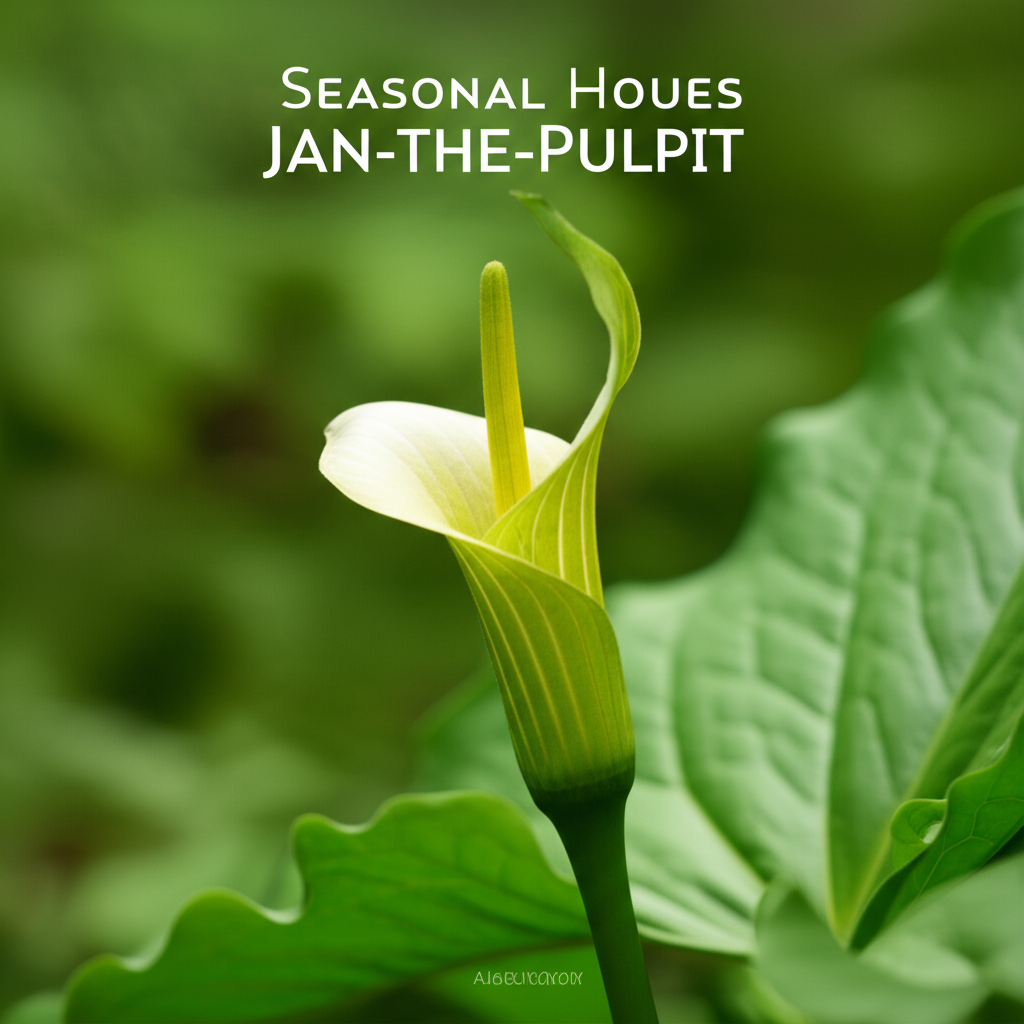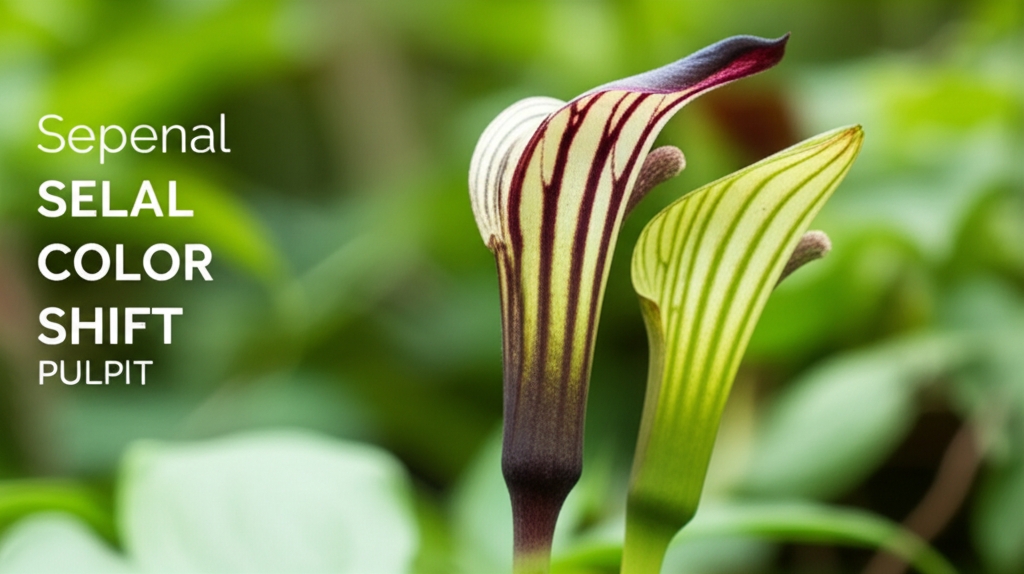Introduction: Unveiling the Enigmatic Jack-in-the-Pulpit
The Jack-in-the-Pulpit, scientifically known as Arisaema triphyllum, is a woodland perennial that captivates botanists and amateur gardeners alike with its unique and intriguing appearance. Native to the eastern United States and Canada, this plant is a master of camouflage and adaptation, often blending seamlessly into the dappled shade of its forest floor habitat. Its common name derives from its distinctive flower structure, which resembles a preacher (the “Jack”) standing within a pulpit. However, beyond its iconic form, the Jack-in-the-Pulpit exhibits a fascinating, albeit subtle, transformation in its coloration throughout its annual life cycle, a phenomenon often overlooked in casual observation. This article will delve into the seasonal nuances of the Jack-in-the-Pulpit’s color, exploring the factors that influence these changes and the ecological significance of its appearance.
The Jack-in-the-Pulpit’s Iconic Structure: A Closer Look

Before examining the color changes, it’s essential to understand the plant’s anatomy. The Jack-in-the-Pulpit possesses a corm, an underground storage organ, from which its leaves and the distinctive spathe and spadix emerge. The plant typically displays one or two trifoliate leaves, meaning each leaf is divided into three leaflets. The “pulpit” is actually a spathe, a modified leaf that enfolds the spadix, which is a fleshy spike bearing tiny flowers. The spathe, the most visually striking part, can exhibit a range of colors, from deep purples and greens to striped patterns. The spadix, often referred to as the “Jack,” can also vary in color and may have an appendage that protrudes from the spathe.
Spathe Coloration: The Primary Canvas of Change
The spathe is the primary area where seasonal color shifts are most apparent in the Jack-in-the-Pulpit. While often described as green, the reality is far more complex. The spathe’s base color can range from pale green to a dark, almost blackish-purple. Interspersed with these base colors are often intricate veining patterns and stripes. These markings, along with the overall hue, are influenced by a confluence of genetic predispositions and environmental factors.
Spadix Coloration: A Subtle but Significant Indicator
The spadix, while less prominent than the spathe, also undergoes color variations. The spadix can be green, brown, or purplish, and its appendage, if present, often mirrors these shades. The exact coloration of the spadix can offer clues about the plant’s reproductive stage and overall health.
Seasonal Color Shifts: A Year in the Life of the Jack-in-the-Pulpit
The Jack-in-the-Pulpit’s appearance is intrinsically linked to the rhythm of the seasons. Its visible presence above ground is relatively short-lived, typically emerging in early spring and fading by late summer or early autumn. Understanding these seasonal phases is key to appreciating its color evolution.
Spring Emergence: The Green Awakening
As the snow melts and the forest floor warms, the Jack-in-the-Pulpit begins its ascent. In early spring, the emerging spathes are often predominantly green. This coloration serves as excellent camouflage against the burgeoning green foliage of the forest understory. The veins on the spathe might be a lighter green or even a subtle purplish hue. At this stage, the plant is focused on unfurling its leaves and preparing for flowering and eventual fruiting. The green coloration likely aids in photosynthesis, providing energy for its reproductive endeavors.
Flowering and Pollination: Deepening Hues and Intricate Patterns
As the plant matures and enters its flowering period, which typically occurs in late spring to early summer, the colors of the spathe can become more intense and varied. While green remains a dominant component for many individuals, a significant proportion develop deeper purple or reddish-brown coloration. This intensification of color is thought to be influenced by increased exposure to sunlight and hormonal changes associated with reproduction.
The intricate veining and striping also become more pronounced. These patterns are not merely decorative; they are believed to play a role in attracting pollinators. Some studies suggest that the darker pigments may absorb more heat, creating a warmer microclimate around the spadix, which can be attractive to certain insects. The specific patterns might also serve as visual cues, guiding pollinators to the reproductive structures.
Late Summer and Fruiting: The Transition to Berry Formation
After successful pollination, the spathe begins to wither and the plant shifts its focus to producing berries. The spathe’s vibrant colors start to fade, often taking on a duller, more muted green or brownish hue. The intricate patterns may become less distinct. This senescence is a natural part of the plant’s life cycle, as its energy is now channeled into developing the fruit.
The distinctive berry clusters, which emerge from the base of the withered spathe, are typically bright red. These berries are a crucial component of the Jack-in-the-Pulpit’s reproductive strategy, attracting birds and other animals that will disperse its seeds. The transition from the spathe’s coloration to the bright red of the berries represents a significant visual shift, signaling the end of the flowering season and the beginning of seed dispersal.
Autumn Decline: Fading into the Background
By late summer and early autumn, the Jack-in-the-Pulpit’s above-ground structures have largely withered and decomposed, returning nutrients to the soil. The vibrant colors of the spring and summer have completely faded, and the plant becomes indistinguishable from the leaf litter on the forest floor, completing its annual cycle.
Factors Influencing Jack-in-the-Pulpit Color
Several factors contribute to the remarkable variation and seasonal changes observed in the Jack-in-the-Pulpit’s coloration. Understanding these influences provides a deeper appreciation for the plant’s adaptability.
Genetics: The Blueprint for Color
The fundamental color palette of a Jack-in-the-Pulpit is determined by its genetic makeup. Different ecotypes and individual plants within a species will have inherent tendencies towards certain colorations. Some individuals are genetically predisposed to produce more anthocyanins, the pigments responsible for red, purple, and blue hues, while others will primarily express chlorophyll, the green pigment. This genetic variability ensures a diverse population, potentially increasing the species’ resilience to environmental changes.
Environmental Factors: The Sculptors of Hue
While genetics provides the blueprint, environmental factors act as the sculptors, refining and influencing the expression of color.
Sunlight Exposure: A Key Driver
The amount of sunlight a Jack-in-the-Pulpit receives is perhaps the most significant environmental factor influencing its color. Plants growing in deeper shade tend to be more uniformly green, relying on chlorophyll for photosynthesis. Conversely, individuals exposed to more direct sunlight, especially during the flowering period, often develop richer purple or reddish-brown coloration. This is because sunlight stimulates the production of anthocyanins, which can act as a protective mechanism against UV radiation and also serve to attract pollinators.
Soil Conditions: Subtle Influences
While not as pronounced as sunlight, soil pH and nutrient availability can also play a subtle role in the plant’s coloration. Variations in soil chemistry might influence the plant’s ability to synthesize and transport pigments. However, research on this specific aspect is less extensive compared to the impact of light.
Temperature: A Contributing Element
Temperature fluctuations, particularly during the spring and early summer, can also influence pigment development. Cooler nights combined with sunny days can sometimes enhance the intensity of anthocyanin production, leading to deeper purples and reds.
Ecological Significance of Coloration
The color changes observed in the Jack-in-the-Pulpit are not merely aesthetic; they serve important ecological functions, contributing to the plant’s survival and reproductive success.
Pollinator Attraction: A Visual Lure
As mentioned earlier, the vibrant colors and intricate patterns of the spathe are believed to play a crucial role in attracting pollinators, primarily insects such as flies, gnats, and bees. The darker pigments might create a warmer microenvironment around the spadix, or the patterns themselves might mimic decaying organic matter, which attracts certain types of flies. The success of pollination directly impacts the plant’s ability to produce viable seeds.
Seed Dispersal: The Bright Red Signal
The transition to the bright red berries in late summer is a clear signal for seed dispersal. These vibrant fruits are highly attractive to birds and small mammals, which consume the berries and then deposit the seeds elsewhere, aiding in the plant’s propagation. The contrast between the fading spathe and the brilliant red berries ensures that the dispersal agents can easily locate the fruit.
Camouflage and Protection: Blending In and Standing Out
The green coloration of the spathe in early spring provides excellent camouflage against the nascent green foliage of the forest floor, helping to protect the vulnerable emerging plant from herbivores. As the plant matures and its reproductive structures become more prominent, the development of darker colors can offer protection from excessive UV radiation in sunnier locations.
Key Facts and Comparison of Seasonal Coloration
To summarize the observable color changes throughout the year, the following table highlights the key characteristics:
| Season | Primary Structure Observed | Dominant Spathe Color | Spathe Pattern/Markings | Spadix Color | Ecological Role |
|---|---|---|---|---|---|
| Early Spring | Emerging Spathe & Leaves | Predominantly Green | Subtle green veining | Green | Camouflage, initial growth |
| Late Spring / Early Summer | Mature Spathe & Flowering | Green with significant purple/reddish-brown variations; striped | Pronounced veining and striping | Green, brown, or purple | Pollinator attraction, reproduction |
| Late Summer / Early Autumn | Withered Spathe & Berry Development | Dull Green/Brownish, fading | Less distinct | (Not prominently visible) | Transition to fruiting |
| Fruiting Stage (Late Summer/Autumn) | Berry Clusters | Decomposed/Absent | N/A | N/A | Seed dispersal (red berries) |
Understanding the Jack-in-the-Pulpit: A Practical Guide
For those interested in cultivating or simply observing the Jack-in-the-Pulpit, understanding its seasonal color changes can enhance the experience.
| Aspect | Description | Pros | Cons |
|---|---|---|---|
| Cultivation Difficulty | Moderately easy in suitable woodland conditions. | Low maintenance once established. | Requires specific shade and moisture conditions. |
| Seasonal Visual Interest | High, from spring emergence to autumn berries. | Provides a dynamic and ever-changing display. | Above-ground presence is relatively short. |
| Color Variation | Significant, with green and purple/striped forms common. | Adds to the aesthetic appeal and uniqueness. | Can make identification of specific forms challenging. |
| Ecological Contribution | Supports pollinators and provides food for wildlife. | Beneficial for local ecosystems. | Requires protection from excessive disturbance. |
| Reproductive Cycle | Monoecious (can be male or female in different years, or even both), with sex determination influenced by corm size and age. | Intriguing biological adaptation. | Sex determination can be complex to observe. |
Conclusion: The Enduring Fascination of a Changing Palette
The Jack-in-the-Pulpit, Arisaema triphyllum, is far more than just a plant with an odd name and an unusual shape. It is a testament to the intricate adaptations of nature, and its seasonal color transformations are a subtle yet profound aspect of its life cycle. From the verdant green of spring, through the richly patterned and pigmented spathes of summer, to the striking red berries that signal the end of its active season, the Jack-in-the-Pulpit orchestrates a quiet symphony of color. This changing palette is not merely for our viewing pleasure; it is a vital component of its ecological strategy, ensuring its survival and propagation within the dappled light of the woodland. By observing these seasonal shifts, we gain a deeper appreciation for the complex interplay between genetics, environment, and the enduring beauty of the natural world.


